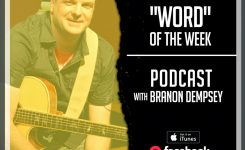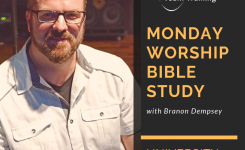Uncategorized
Kent Morris | Sound Advice 6-20-17
Time: 30m video
Know Your Board
As a Worship Leader or Sound Tech, do you ever feel unsure of how to use your sound board? Do you know how to use EQ effectively?
What about the effects? Sound boards are a powerful tool for worship teams, but used incorrectly they can actually be a hindrance and a distraction. Boost your confidence this week with special guest Kent Morris.
Kent is a sound guru, and he has a wealth of knowledge about getting the most out of your sound system.
Learn how to get the most of our your sound board, using EQ, effects and more!
Kent Morris on LinkedIn
2. How do you work through learning all of the features of a sound board?
3. What do you do to encourage others in your team about being fully trained?
4. Simply, what is your role as a servant and how do you exhibit this in your ministry?
Keystone Thought:
[ctt template=”6″ link=”7Pl1I” via=”no” ]The first step in proper EQ technique is to realize the knobs go to the left better than they go to the right [/ctt]
Since human hearing is most sensitive to frequencies in the mid-band and most instruments produce a majority of their fundamental and initial order harmonics in the same region, there is too much energy localized between 250 Hz and 2.5 kHz.
Tubby – 125 Hz is a common resonant frequency in church auditoriums. Stage rumble can be reduced by eliminating (-9 dB) the frequencies below 125 Hz on the graphic EQ assigned to the main stage monitors.
Boomy – 160 Hz is “fake bass,” a tone associated with a wimpy boom box trying to reproduce the solid fundamental tone of kick drum and bass guitar that occur at 80 Hz. Because an octave is a doubling or halving of frequency, boom-bass is an octave above real bass. Pulling out 5 dB at 160 Hz will clear up the rhythm section.
Muddy – 250 Hz is the most effective region to grab and reduce “masked” energy from the sound system. If you can do one thing, reduce 250 Hz by 3 dB.
Boxy – 400 Hz is the fundamental tone of most male and some female voices. Too much of it can trap the energy into a localized source without any ‘air” or ‘breadth.”
Honky – 800 Hz is the leading culprit behind exquisite grand pianos that sound like a cheap honky-tonk upright through the PA. The pianist will thank you for removing 4-6 dB in this region.
Nasal – 1000 Hz (1 kHz) is the nasty tone in some reproduced lyrical vocals as well as the tone that gives away a digital piano as an unreal instrument. Take out 3 dB and watch the reaction.
Vox Box – 2 kHz is the chosen pre-emphasized frequency for many stage grade vocal mics. While it allows the vocal to “cut through” the mix, too much of it can spoil a good thing. It’s already boosted in the mic; don’t add to it.
Fatigue – 3.5 kHz is the most sensitive region of the human hearing system. Unfortunately, many audio engineers have significant hearing loss around this zone, so they compensate with too much of too much. If your ears tire of the mix after 30 minutes, it’s time to pull back 4 dB here.
Sizzling – 5 kHz is a wonderfully definitive region, but too much on hi-hat and snare can reduce the audience to mush. Super cardioid condenser mics tend to emphasize 5 kHz and produce a “harsh” tonality. However, much more than a 3 dB cut risks losing the vocal articulation.
Zingers – 8 lHz is a necessary part of music, but it removes heads when it oscillates into feedback, so never add it, just subtract its decade differential at 800 Hz. In fact, any needed boost can usually be found by reducing the frequency ten times less or more than its value. To increase clarity at 4 kHz, reduce 400 Hz by 4 dB. To get the vocals to cut through at 2 kHz, remove energy at 200 Hz. For pounding kick drum at 60 Hz, reduce 600 Hz.
@KentMorris1 @BranonDempsey @worshiptt @WorshipTTU
Want More Training? Upgrade Your Membership
Worship Team Training® Is your Audio Team or Worship Team stuck? Want worship leading to be better? Want to be free? We can take you there. Inspire, create and transform the leading of worship. Get a WeekendWorkshop
Copyright 2017 Worship Team Training®
What about the effects? Sound boards are a powerful tool for worship teams, but used incorrectly they can actually be a hindrance and a distraction. Boost your confidence this week with special guest Kent Morris.
Kent is a sound guru, and he has a wealth of knowledge about getting the most out of your sound system.
Learn how to get the most of our your sound board, using EQ, effects and more!
6-22-17 WATCH SHOW: KENT MORRIS!
FEATURED GUEST’S LINKS:
www.Facebook.com/CornerstoneMediaKent Morris on LinkedIn
QUESTIONS:
1. As a tech professional, what is most important to you about the role of a sound engineer?2. How do you work through learning all of the features of a sound board?
3. What do you do to encourage others in your team about being fully trained?
4. Simply, what is your role as a servant and how do you exhibit this in your ministry?
Keystone Thought:
[ctt template=”6″ link=”7Pl1I” via=”no” ]The first step in proper EQ technique is to realize the knobs go to the left better than they go to the right [/ctt]
Left Is Right
The first step in proper EQ technique is to realize the knobs go to the left better than they go to the right (or in the case of faders, down rather than up). In other words, reduction of energy is more beneficial than an increase in energy, due to the nature of live sound. Live music in particular is awash in competing frequencies from melody and rhythm instruments in struggle with cascading voices emanating from the stage and the audience.Since human hearing is most sensitive to frequencies in the mid-band and most instruments produce a majority of their fundamental and initial order harmonics in the same region, there is too much energy localized between 250 Hz and 2.5 kHz.
Tubby, Honky and Boomy
Again, though, without knowing where to cut the energy levels, the cure will be worse than the disease. Here, then, are several descriptive words and the corresponding frequency most attuned to the problem area:Tubby – 125 Hz is a common resonant frequency in church auditoriums. Stage rumble can be reduced by eliminating (-9 dB) the frequencies below 125 Hz on the graphic EQ assigned to the main stage monitors.
Boomy – 160 Hz is “fake bass,” a tone associated with a wimpy boom box trying to reproduce the solid fundamental tone of kick drum and bass guitar that occur at 80 Hz. Because an octave is a doubling or halving of frequency, boom-bass is an octave above real bass. Pulling out 5 dB at 160 Hz will clear up the rhythm section.
Muddy – 250 Hz is the most effective region to grab and reduce “masked” energy from the sound system. If you can do one thing, reduce 250 Hz by 3 dB.
Boxy – 400 Hz is the fundamental tone of most male and some female voices. Too much of it can trap the energy into a localized source without any ‘air” or ‘breadth.”
Honky – 800 Hz is the leading culprit behind exquisite grand pianos that sound like a cheap honky-tonk upright through the PA. The pianist will thank you for removing 4-6 dB in this region.
Nasal – 1000 Hz (1 kHz) is the nasty tone in some reproduced lyrical vocals as well as the tone that gives away a digital piano as an unreal instrument. Take out 3 dB and watch the reaction.
Vox Box – 2 kHz is the chosen pre-emphasized frequency for many stage grade vocal mics. While it allows the vocal to “cut through” the mix, too much of it can spoil a good thing. It’s already boosted in the mic; don’t add to it.
Fatigue – 3.5 kHz is the most sensitive region of the human hearing system. Unfortunately, many audio engineers have significant hearing loss around this zone, so they compensate with too much of too much. If your ears tire of the mix after 30 minutes, it’s time to pull back 4 dB here.
Sizzling – 5 kHz is a wonderfully definitive region, but too much on hi-hat and snare can reduce the audience to mush. Super cardioid condenser mics tend to emphasize 5 kHz and produce a “harsh” tonality. However, much more than a 3 dB cut risks losing the vocal articulation.
Zingers – 8 lHz is a necessary part of music, but it removes heads when it oscillates into feedback, so never add it, just subtract its decade differential at 800 Hz. In fact, any needed boost can usually be found by reducing the frequency ten times less or more than its value. To increase clarity at 4 kHz, reduce 400 Hz by 4 dB. To get the vocals to cut through at 2 kHz, remove energy at 200 Hz. For pounding kick drum at 60 Hz, reduce 600 Hz.
Recap
As with everything in audio, these tips are just a guideline. However, they have proven effective in hundreds of live concerts and thousands of worship services, so feel free to start turning, as long as it’s to the left.@KentMorris1 @BranonDempsey @worshiptt @WorshipTTU
Want More Training? Upgrade Your Membership

Worship Team Training® Is your Audio Team or Worship Team stuck? Want worship leading to be better? Want to be free? We can take you there. Inspire, create and transform the leading of worship. Get a WeekendWorkshop
Copyright 2017 Worship Team Training®





